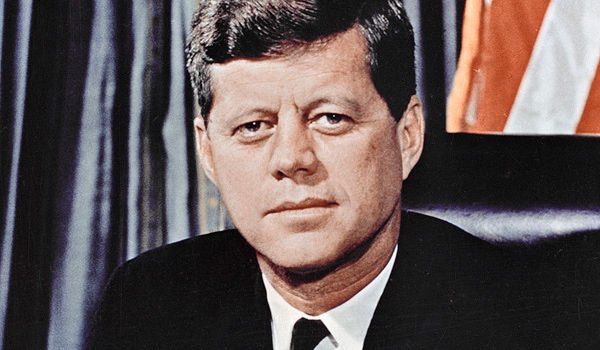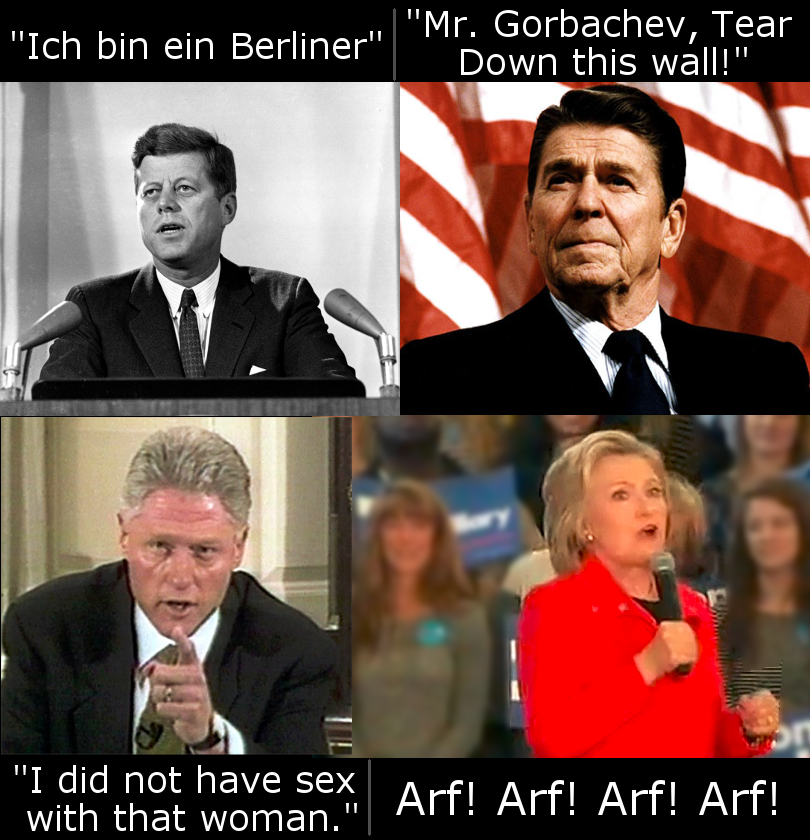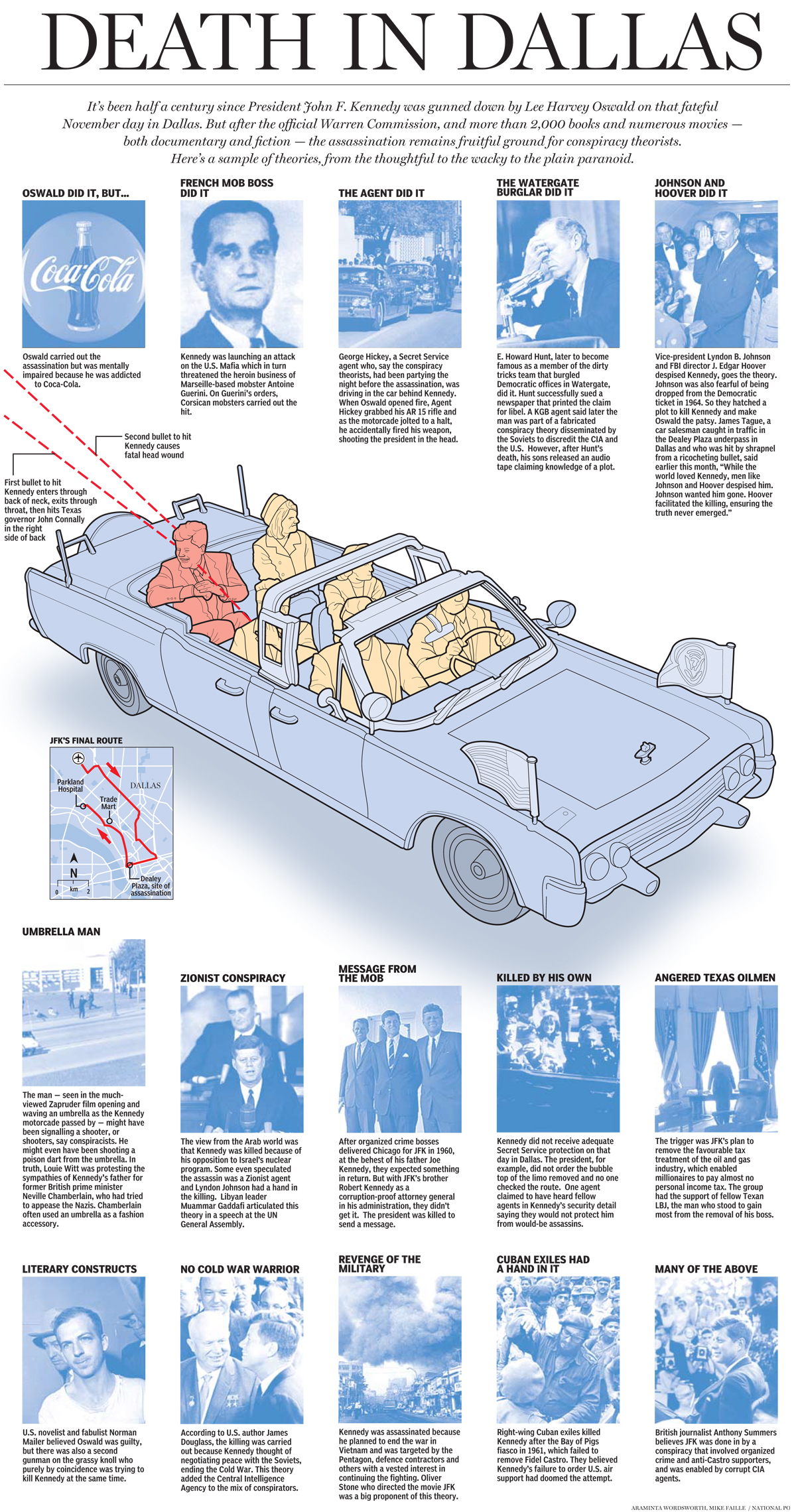The CIA Kennedy assassination theory is a prominent John F. Kennedy assassination conspiracy theory. The CIA is represented in nearly every theory that involves American conspirators. The secretive nature of the CIA, and the conjecture surrounding high-profile political assassinations in the United States during the 1960s, has made the CIA a plausible suspect for some who believe in a conspiracy.
WikiLeaks tweeted the decryption passphrase for the CIA Vault 7 leak. The password is, “I will splinter the CIA into a thousand pieces and scatter it into the wind,” a quote credited to President John F. Kennedy.
RELEASE: CIA Vault 7 Year Zero decryption passphrase:
SplinterItIntoAThousandPiecesAndScatterItIntoTheWinds
— WikiLeaks (@wikileaks) March 7, 2017
The quote was given to a Times journalist in the 1960s by a Kennedy administration official and published in the New York Times on April 25, 1966 in an article titled “C.I.A.: Maker of Policy, or Tool?” Read it here.
The video below references the JFK quote at the 2:50-mark.
The 6:15-minute video centers on Samuel Halpern discussing JFK’s relationship with the Central Intelligence Agency. Halpern was involved in the investigation of the assassination of John F. Kennedy.
Halpern says that the CIA is not all bad, but that the organization is highly individualistic.
The video focuses on Kennedy’s relationship with Cuba prior to his assassination by Lee Harvey Oswald and discusses Operation Northwoods, a proposed false flag operation against the Fidel Castro regime, that originated within the U.S. Department of Defense. According to ABC News, “the plans reportedly included the possible assassination of Cuban émigrés, sinking boats of Cuban refugees on the high seas, hijacking planes, blowing up a U.S. ship, and even orchestrating violent terrorism in U.S. cities.”
Kennedy refused the plan, but the CIA still wanted to deal with Cuba.
In the video, Halpern says he could never figure out why the CIA wanted to punish Cuba so badly but that he thought maybe it had to do with hubris. It’s then stated that JFK was finding it increasingly difficult to keep former Director of Central Intelligence Allen Dulles “in line” and that the agency was becoming a “state within the state.”
Convenient Deaths
1963 – 1976
In the three year period following the assassination many witnesses died – mostly of unnatural causes. Many rumors crawling around about the high death rate during these years. They are supported by the mostly suspicious circumstances the victims died under. For a unknown shooter or even shooters, all these deaths have on thing in common: they are very convenient to those assassins since these witnesses took their knowledge with them into the grave. But see yourself and decide whether these deaths are purely coincidently:
| Date | Name | Connection with case | Cause of death |
|---|---|---|---|
| 11/63 | Karyn Kupicinet | Tv host’s daughter who was overheard telling of JFK’s death prior to 11/22/63 | Murdered |
| 12/63 | Jack Zangretti | Expressed foreknowledge of Ruby shooting Oswald | Gunshot Victim |
| 2/64 | Eddy Benavides | Lookalike brother to Tippit shooting witness, Domingo Benavides | Gunshot to head |
| 2/64 | Betty MacDonald* | Former Ruby employee who alibied Warren Reynolds shooting suspect. | Suicide by hanging in Dallas Jail |
| 3/64 | Bill Chesher | Thought to have information linking Oswald and Ruby | Heart attack |
| 3/64 | Hank Killam* | Husband of Ruby employee, knew Oswald acquaintance | Throat cut |
| 4/64 | Bill Hunter* | Reporter who was in Ruby’s apartment on 11/24/63 | Accidental shooting by policeman |
| 5/64 | Gary Underhill* | CIA agent who claimed Agency was involved | Gunshot in head ruled suicide |
| 5/64 | Hugh Ward* | Private investigator working with Guy Banister and David Ferrie | Plane crash in Mexico |
| 5/64 | DeLesseps Morrison* | New Orleans Mayor | Passenger in Ward’s plane |
| 8/64 | Teresa Norton* | Ruby employee | Fatally shot |
| 6/64 | Guy Banister* | x-FBI agent in New Orleans connected to Ferrie, CIA, Carlos Marcello & Oswald | Heart attack |
| 9/64 | Jim Koethe* | Reporter who was in Ruby’s apartment on 11/24/63 | Blow to neck |
| 9/64 | C.D. Jackson | “Life” magazine senior Vice-president who bought Zapruder film and locked it away | Unknown |
| 10/64 | Mary Pinchot | JFK “special” friend whose diary was taken by CIA chief James Angleton after her death | Murdered |
| 1/65 | Paul Mandal | “Life” writer who told of JFK turning to rear when shot in throat | Cancer |
| 3/65 | Tom Howard* | Ruby’s first lawyer, was in Ruby’s apartment on 11/24/63 | Heart attack |
| 5/65 | Maurice Gatlin* | Pilot for Guy Banister | Fatal fall |
| 8/65 | Mona B. Saenz* | Texas Employment clerk who interviewed Oswald | Hit by Dallas bus |
| ?/65 | David Goldstein | Dallasite who helped FBI trace Oswald’s pistol | Natural causes |
| 9/65 | Rose Cheramie* | Knew of assassination in advance, told of riding to Dallas with Cubans | Hit/run victim |
| 11/65 | Dorothy Kilgallen* | Columnist who had private interview with Ruby, pledged to “break” JFK case | Drug overdose |
| 11/65 | Mrs. Earl Smith* | Close friend to Dorothy Kilgallen, died two daysafter columnist, may have kept Kilgallen’s notes | Cause unknown |
| 12/65 | William Whaley* | Cab driver who reportedly drove Oswald to Oak Cliff (The only Dallas taxi driver to die on duty) | Motor collision |
| 1966 | Judge Joe Brown | Presided over Ruby’s trial | Heart attack |
| 1966 | Karen “Little Lynn” Carlin* | Ruby employee who last talked with Ruby before Oswald shooting | Gunshot victim |
| 1/66 | Earlene Roberts | Oswald’s landlady | Heart attack |
| 2/66 | Albert Bogard* | Car salesman who said Oswald test drove new car | Suicide |
| 6/66 | Capt. Frank Martin | Dallas policeman who witnessed Oswald slaying, told Warren Commission “there’s a lot to be said but probably be better if I don’t say it” | Sudden cancer |
| 8/66 | Lee Bowers Jr.* | Witnessed men behind picket fence on Grassy Knoll | Motor accident |
| 9/66 | Marilyn “Delila Walle* | Ruby dancer | Shot by husband after 1 month of marriage |
| 10/66 | Lt. William Pitzer* | JFK autopsy photographer who described his duty as “horrifying experience” | Gunshot ruled suicide |
| 11/66 | Jimmy Levens | Fort Worth nightclub owner who hired Ruby employees | Natural causes |
| 11/66 | James Worrell Jr.* | Saw man flee rear of Texas School Book Depository | Motor accident |
| 1966 | Clarence Oliver | Dist. Atty. Investigator who worked Ruby case | Unknown |
| 12/66 | Hank Suydam | Life magazine official in charge of JFK stories | Heart attack |
| 1967 | Leonard Pullin | Civilian Navy employee who helped film “Last Two Days” about assassination | One-car crash |
| 1/67 | Jack Ruby* | Oswald’s slayer | Lung cancer (he told family he was injected with cancer cells) |
| 2/67 | Harold Russell* | Saw escape of Tippit killer | killed by cop in bar brawl |
| 2/67 | David Ferrie* | Acquaintance of Oswald, Garrison suspect and employee of Guy Banister | Blow to neck (ruled accidental) |
| 2/67 | Eladio Del Valle* | Anti-Castro Cuban associate of David Ferrie being sought by Garrison | Gunshot wound, ax wound tohead |
| 3/67 | Dr. Mary Sherman* | Ferrie associate working on cancer research | Died in fire (possibly shot) |
| 1/68 | A. D. Bowie | Asst. Dallas District Attorney prosecuting Ruby | Cancer |
| 4/68 | Hiram Ingram | Dallas Deputy Sheriff, close friend to Roger Craig | Sudden cancer |
| 5/68 | Dr. Nicholas Chetta | New Orleans coroner who on death of Ferrie | Heart attack |
| 8/68 | Philip Geraci* | Friend of Perry Russo, told of Oswald/Shaw conversation | Electrocution |
| 1/69 | Henry Delaune* | Brother-in-law to coroner Chetta | Murdered |
| 1/69 | E.R. Walthers* | Dallas Deputy Sheriff who was involved in Depository search, claimed to have found .45-cal. slug | Shot by felon |
| 1969 | Charles Mentesana | Filmed rifle other than Mannlicher-Carcano being taken from Depository | Heart attack |
| 4/69 | Mary Bledsoe | Neighbor to Oswald, also knew David Ferrie | Natural causes |
| 4/69 | John Crawford* | Close friend to both Ruby and Wesley Frazier, who gave ride to Oswald on 11/22/63 | Crash of private plane |
| 7/69 | Rev. Clyde Johnson* | Scheduled to testify about Clay Shaw/Oswald connection | Fatally shot |
| 1970 | George McGann* | Underworld figure connected to Ruby friends, wife, Beverly, took film in Dealey Plaza | Murdered |
| 1/70 | Darrell W. Garner | Arrested for shooting Warren Reynolds, released after alibi from Betty MacDonald | Drug overdose |
| 8/70 | Bill Decker | Dallas Sheriff who saw bullet hit street in front of JFK | Natural causes |
| 8/70 | Abraham Zapruder | Took famous film of JFK assassination | Natural causes |
| 12/70 | Salvatore Granello* | Mobster linked to both Hoffa,Trafficante, and Castro assassination plots | Murdered |
| 1971 | James Plumeri* | Mobster tied to mob-CIA assassination plots | Murdered |
| 3/71 | Clayton Fowler | Ruby’s chief defense attorney | Uknown |
| 4/71 | Gen. Charles Cabell* | CIA deputy director connected to anti-Castro Cubans | Collapsed and died afterphysical at Fort Myers |
| 1972 | Hale Boggs* | House Majority Leader, member of Warren Commission who began to publicly express doubts about findings | Disappeared on Alaskan plane flight |
| 5/72 | J. Edgar Hoover* | FBI director who pushed “lone assassin” theory in JFK assassination | Heart attack (no autopsy) |
| 9/73 | Thomas E. Davis* | Gunrunner connected to both Ruby and CIA | Electrocuted trying to steal wire |
| 2/74 | J.A. Milteer* | Miami right-winger who predicted JFK’s death and capture of scapegoat | Heater explosion |
| 1974 | Dave Yaras* | Close friend to both Hoffa and Jack Ruby | Murdered |
| 7/74 | Earl Warren | Chief Justice who reluctantly chaired Warren Commission | Heart failure |
| 8/74 | Clay Shaw* | Prime suspect in Garrison case, reportedly a CIA contact with Ferrie and E. Howard Hunt | Possible cancer |
| 1974 | Earle Cabell | Mayor of Dallas on 11/22/63, whose brother, Gen. Charles Cabell was fired from CIA by JFK | Natural causes |
| 6/75 | Sam Giancana* | Chicago Mafia boss slated to tell about CIA-mob death plots to Senate Committee | Murdered |
| 7/75 | Clyde Tolson | J. Edgar Hoover’s assistant and roommate | Natural causes |
| 1975 | Allen Sweatt | Dallas Deputy Sheriff involved in investigation | Natural causes |
| 12/75 | Gen. Earle Wheeler | Contact between JFK and CIA | Unknown |
| 1976 | Ralph Paul | Ruby’s business partner connected with crime figures | Heart attack |
| 4/76 | James Chaney | Dallas motorcycle officer riding to JFK’s right rear who said JFK “struck in the face” with bullet | Heart attack |
| 4/76 | Dr. Charles Gregory | Governor John Connally’s physician | Heart attack |
| 6/76 | William Harvey* | CIA coordinator for CIA-mob assassination plans against Castro | Complications from heart surgery |
| 7/76 | John Roselli* | Mobster who testified to Senate Committee and was to appear again | Stabbed and stuffed in metal drum |
The HSCA Investigation
Just when the House Select Committee on Assassinations was investigating the JFK assassination, more suspicious deaths were coming up:
| Date | Name | Connection with case | Cause of Death |
|---|---|---|---|
| 1/77 | William Pawley* | Former Brazilian Ambassador connected to Anti-Castro Cubans, crime figures | Gunshot ruled suicide |
| 3/77 | George DeMohrenschildt* | Close friend to both Oswald and Bouvier family (Jackie Kennedy’s parents), CIA contract agent | Gunshot wound ruled suicide |
| 3/77 | Carlos Prio Soccaras* | Former Cuban President, money man for anti-Castro Cubans | Gunshot wound ruled suicide |
| 3/77 | Paul Raigorodsky | Business friend of George DeMohrenschildt and wealthy oilmen | Natural causes |
| 5/77 | Lou Staples* | Dallas radio Talk Show host who told friends he would break assassination case | Gunshot to head,ruled suicide |
| 6/77 | Louis Nichols | Former No. 3 man in FBI, worked on JFK investigation | Heart attack |
| 8/77 | Alan Belmont | FBI official who testified to Warren Commission | “Long illness” |
| 8/77 | James Cadigan | FBI document expert who testified to Warren Commission | Fall in home |
| 8/77 | Joseph C. Ayres* | Chief steward on JFK’s Air Force One | Shooting accident |
| 8/77 | Francis G. Powers* | U-2 pilot downed over Russia in 1960 | Helicopter crash (He reportedly ran out of fuel) |
| 9/77 | Kenneth O’Donnell | JFK’s closest aide | Natural causes |
| 10/77 | Donald Kaylor | FBI fingerprint chemist | Heart attack |
| 10/77 | J.M. English | Former head of FBI Forensic Sciences Laboratory | Heart attack |
| 11/77 | William Sullivan* | Former No. 3 man in FBI, headed Division 5, counter- espionage and domestic intelligence | Hunting accident |
| 1978 | C.L. “Lummie” Lewis | Dallas Deputy Sheriff who arrested Mafia man Braden in Dealey Plaza | Natural causes |
| 9/78 | Garland Slack | Man who said Oswald fired at his target at rifle range | Unknown |
| 1/79 | Billy Lovelady | Depository employee said to be the man in the doorway in AP photograph | Complications from heart attack |
| 6/80 | Jesse Curry | Dallas Police Chief at time of assassination | Heart attack |
| 6/80 | Dr. John Holbrook | Psychiatrist who testified Ruby was not insane | Heart attack but pills, notes found, |
| 1/81 | Marguerite Oswald | Mother of accused assassin | Cancer |
| 10/81 | Frank Watts | Chief felony prosecutor for Dallas D.A. | Natural causes |
| 1/82 | Peter Gregory | Original translator for Marina Oswald and Secret Service | Natural causes |
| 5/82 | Dr. James Weston | Pathologist allowed to see JFK autopsy material for HSCA | Died while jogging, ruled natural causes |
| 8/82 | Will H. Griffin | FBI agent who reportedly said Oswald was “definitely” an FBI informant | Cancer |
| 10/82 | W. Marvin Gheesling | FBI official who helped supervise JFK investigation | “Long illness” |
| 3/84 | Roy Kellerman | Secret Service agent in charge of JFK limousine | Unknown |







